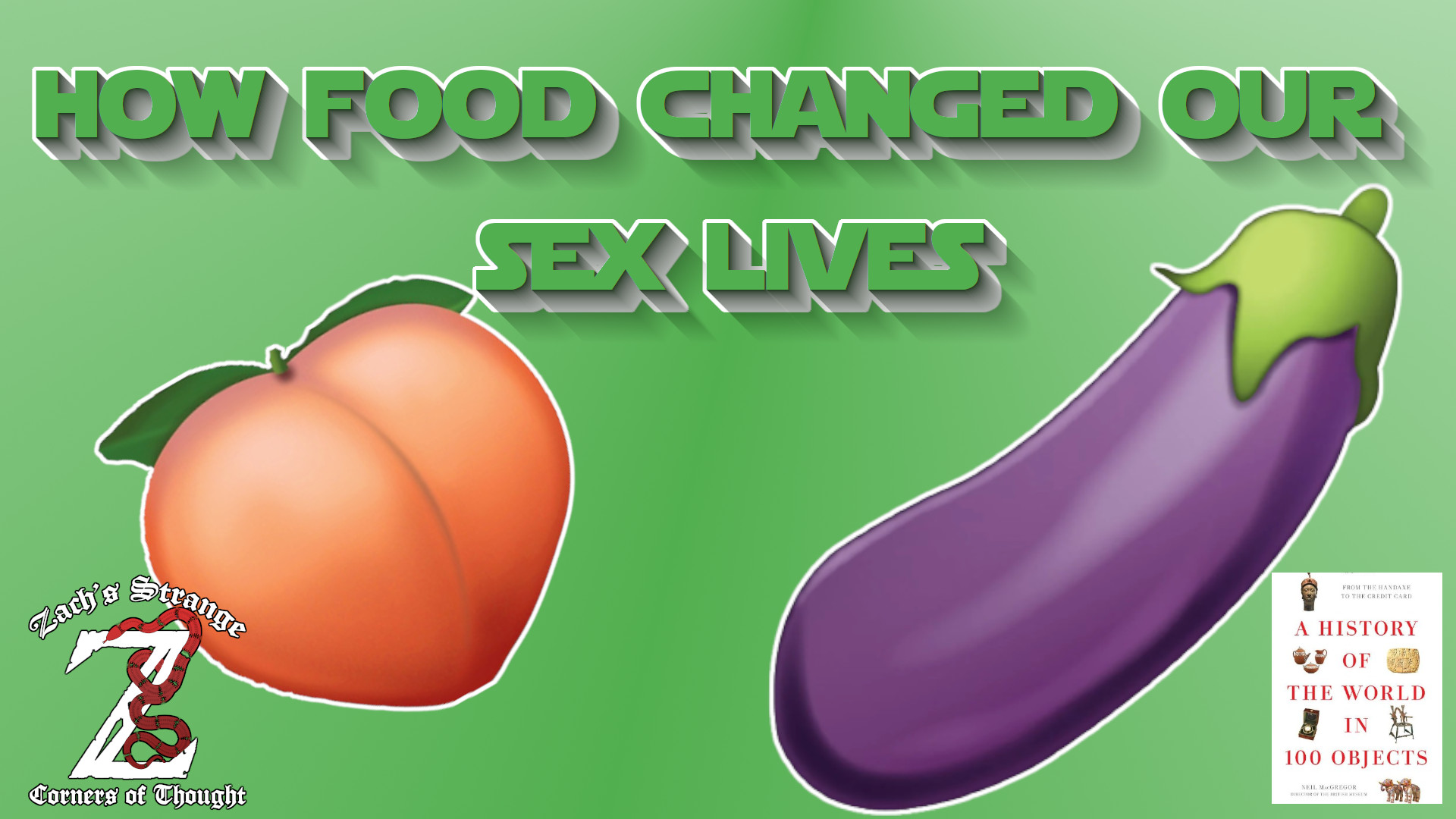9/15/2022
Citations:
Macgregor, Neil. A History of the World in 100 Objects. Viking, 2011. Buy here!
The second 5 historical objects from the book A History of the World in 100 Objects by Neil MacGregor.
After the Ice Age: Food & Sex 9000-3500 B.C.E.
In this video, we’re specifically looking at the period following the last Ice Age, which ended about 10,000 years ago. During this period we find many humans settling down in one place, abandoning nomadic hunter-gatherer lifestyles, and most importantly, learning how to grow their own food on massive scales. We know that agriculture developed in at least seven different parts of the world independently. This skill took several centuries to develop. At the same time, humans began domesticating animals for work and food, creating Gods to explain the cyclic nature of the world and give a peoples a firm foundation. Finally, humans invented new tools to store their abundant food supplies and cook said food to increase its nutrition.
6. Bird-shaped Pestle Stone. Stone pestle, found by the Aikora River, Oro Province, Papua New Guinea 6000-2000 B.C.E.
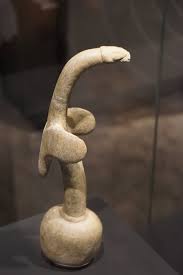
A little over a foot long, it was used to grind food and make it edible. Ancient humans ate Food that often must be soaked or boiled or ground up to be digestible. Why would they do this? Why would humans specifically pick food that was inedible or even poisonous when ingested raw?
“As the human species expanded across the globe, we had to compete with other animals going for easy food. Where we couldn’t compete, we had to go for the difficult food. We went for things like the small hard grass seeds we call cereals, which are indegestible if eaten raw and may even be poisonous, which we have to pulp up and turn into things like bread and dough. And we went into the poisonous giant tubers, like the yam and the taro, which also had to be leeched, ground up and cooked before we could eat them. This is how we gained a competitive advantage – other animals that didn’t have our kind of brain couldn’t think several steps a head to do that.”
Martin Jones, Professor of Archaeological Science at Cambridge University
History of cereal is 10,000 years old:
Wheat in Middle East
Rice in China
Sweetcorn in Central America
Sorghum in Africa
Taro in Papua New Guinea
Kidney beans in Peru
All across the world, new tools had to be invented to extract nutrients out of food that back then was either inedible or poisonous raw. The pestle mentioned above is relatively small, and was likely used mainly during ceremonial or religious functions. These foods were so essential to human life, that people created elaborate rituals, important familial celebrations, and even defied some foods in order to stress the importance of the crops.
7. Ain Sakhri Lovers Figurine. Stone sculpture, found at Wadi Khareitoroun, Judea near Bethlehem 9000 B.C.E.
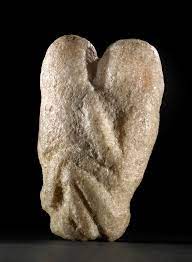
When humans have more free time, they tend to engage in the bouncy-bouncy and make lots of babies. And when you engage in lots of bouncy-bouncy, you want to let people know about it.
“What’s incredible about this sculpture is that when you move it and look at it in different ways, it changes completely. From the side, you have the long shot of the embrace, you see the two figures. From another side it’s a penis, from another a vagina, from another side breasts – it seems to be formerly mimicking the act of making love as well as representing it. And those different sides unfold as you handle it, as you turn this object around in your hand, so they unfold in time, which I think is an important thing about the sculpture – it’s not an instant thing. You walk round it and the object unfolds in real time. It’s almost like in a pornographic film, you have long shots, close-ups – it has a cinematic quality as you turn it, you get all these different things. And yet it’s a poignant, beautiful object about the relationship between people.”
British sculptor Marc Quinn
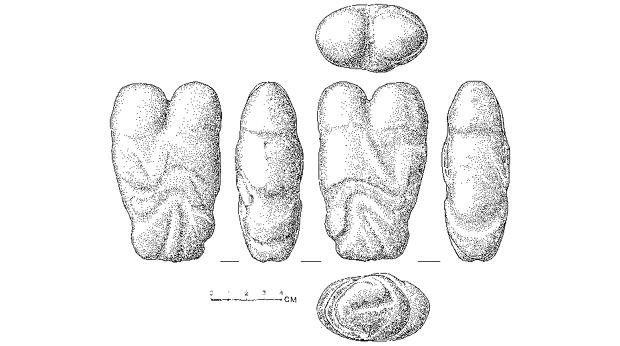
Natufians lived in modern-day Palestine, Lebanon and Syria.
“The Natufian culture is really before fully domesticated plants and animals, but you already have a sedentary society. This particular object, because of its focus on humans and human sexuality in such a clear way, is part of that general shift towards a greater concern with domesticating the mind, domesticating humans, domesticating human society, being more concerned with human relationships, rather than with the relationships between humans and wild animals, and the relationships between wild animals themselves.”
Archaeologist Ian Hodder of Stanford University
Between the ability to produce mass agriculture and human sexuality is a symbiotic relationship between ourselves and the food we turn into ourselves. Humans weren’t just engaging in bouncy-bouncy with each other. They were picking and choosing which foods made babies with which foods. Most wild grass seeds fall off the plant and spread by the elements. This prevents the child plants from being in direct competition with the parent plant. Ancient peoples purposely cultivated plants whose seeds stayed on the stalk. They stripped the seeds, removed the husks, and ground the grain into flour.
Over the millennia, many of the foods we ate which were inedible became increasingly edible as they adapted and as we adapted to these foods.
8. Egyptian Clay Model of Cattle. Painted model, found at Abydos, Egypt. 3500 B.C.E.
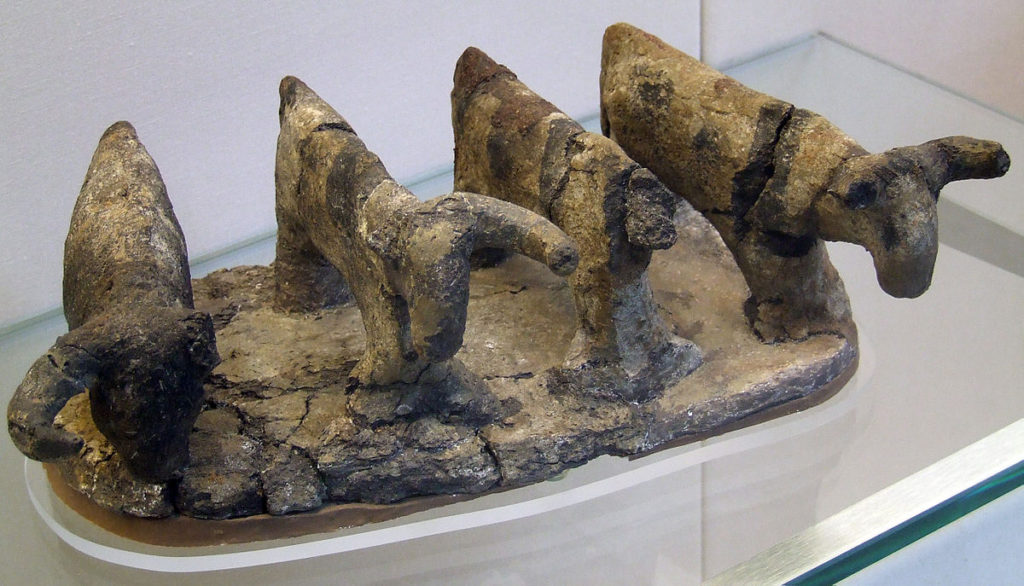
Most of what we know about early Egypt, long before Pharaohs, hieroglyphs, and pyramids, comes from common burial sites like where this statue was found. These objects were placed in the graves to be useful to the person buried in the next world. But, these objects continue to be useful for us in this world. “They allow us profound insights into remote societies, because the way of death casts light on the way of life of those people. They give us some idea not just of what people did but of what they thought and believed.” (45)
While this clay model dates back 5500 years ago, the story goes back another 4000 years. 9,000 years ago the Sahara was made of lush, open savannas with gazelles, giraffes, zebras, elephants, and wild cattle. But the rains which nourished the lush grasslands dried up, and most of the wild animals disappeared along with the food provided by hunting humans. As resources dried up, domesticating these animals was the only way to maintain & control the meat supply. Of all these animals, only cattle could be tamed. Managing domesticated animals became the determining factor in many human societies.
From looking at the animal bones also in these graves, we learn that these cattle died very old. This means they were not primarily beef cows. Useful for labor, manure (fertilizer), and blood (which is a good source of protein). They were originally blood cows, not milk cows. These cows naturally produced very little milk, and humans were still mostly intolerant to lactose.
“There is a range of other foods that our distant ancestors would not have eaten as readily as we do. Humans evolved the capacity to tolerate drinking milk as adults after cattle were domesticated, presumably because the ability to gain nutrients from cows’ milk helped individuals to survive and pass on that ability to their children.”
Martin Jones, Professor of Archaeological Science at Cambridge University
The ability to gain nutrients from cow milk was genetically engineered into us because of the domestication with cattle. At the same time, we genetically engineered cows to produce surplus amounts of milk. Yet, even today, the majority of adult humans can’t tolerate drinking cows’ milk.
“It is a pattern repeated across the world: substances that are initially very hard for us to digest become, by slow adaptation, central to our diet. We are often told that we are what we eat; it might be truer to say that we are what our ancestors, with great difficulty, learnt to eat.” (47)
If we return to the figurine, the cows portrayed are themselves remnants of a different time, as African cows went extinct around the time of the Romans. Their horns are noticeably pointing forward and are much lower on the head. All modern cattle we are used to today descend from Asian cattle.
9. Maya Maize God Statue. Stone Statue, found in Copan, Honduras. 715 C.E.
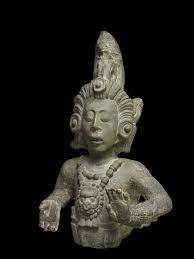
Here is the bust of a god of corn. “Carved from limestone using a stone chisel and a basalt hammer, and the features are large & symmetrical, the eyes closed, the lips parted – as though this god is in communion with a different world, quietly meditating. The arms are bent, the palms of the hands face outwards – one raised, one lower – giving an impression of serene power. The head of the god is covered with an enormous headdress in the shape of a stylized corn cob, and his hair is like the silky strands that line a cob, inside the wrapping leaves.” (49)
Food has likely always had a divine role in our lives. From Dionysus & Demeter, Greek gods of wine and harvest respectively, to the Egyptian cow-goddess Bat, and the Hindu goddess of food Annapurna. Everywhere we see gods of birth, death, and rebirth, gods of the seasons, of the crops, of specific foods. We often say we are what we eat. It was also true that we worshipped what we eat.
This bust is part of that worldwide process. This statue came from one of the pyramid temples in Western Honduras. These statues were often commissioned by rulers and the elites.
“The elite in ancient societies focused on corn as having sacred kinds of properties which they then associated with themselves. This is pretty obvious in the young maize god – the sculpture was apparently a manifestation of mythological beings resulting from the third cycle of creation by the gods. There were eight mythological beings, four women & four men, who were believed to be the ancestors of all the Maya people. The Maya believed that their ancestors essentially came from corn, and they were formed of yellow and white maize dough. Maize was certainly a primary focus of ritual & religious veneration by ancient Meso-American people, going back all the way before the Maya and even into the Olmec civilization.”
Anthropologist John Stalle
Our maize god is an insight into the way ancient american society thought about itself and its ecosystem. He is a god of agriculture and the cycle of life and the literal stuff Central Americans were made up. This tale is recounted in the epic, the Popol Vuh.
“And here is the beginning of the conception of humans and of the search for the ingredients of the human body… So they spoke: the bearer, begetters, the makers, modelers—and a sovereign plumed serpent—they sought and discovered what was needed for human flesh. It was only a short while before the sun, moon, and stars were to appear above the makers and modelers. Split place, bitter water place, is the name, the yellow corn, white corn, came from there. And this was when they found the staple foods, and then the yellow corn and white corn were ground. After that they put into words the making the modeling of our first mother-father, with yellow corn, white corn alone for the flesh, food alone for the human legs and arms for our first fathers, the four human works.” (52)
Popol Vuh
The staple foods of ancient meso-american diet were a trinity of plants: squashes, beans, and maize. There were no easily domesticated animals. We don’t see the same divine importance in meat or squashes or beans. Why maize? Maize derives from the plant teosinte. Teosinte (Teosintee) is able to grow in both dry mountainous regions and wet lowlands. People could farm them year round. Constant harvesting encouraged the growth of larger plants, and maize is rich in carbohydrates.
9,000 years ago, maize had little taste and eating it raw would have made a person ill. The raw kernels needed to be cooked with water and lime. Only then would amino acids and vitamin B be released: vital nutrients for humans. Over time, we selected increasingly edible corn while the corn was selecting humans that could eat corn more easily. Made of corn indeed.
While most food gods are no longer worshiped around the world, these foods are no less connected to us. In fact, many of the plants we produce and eat through mass agriculture would quickly go extinct if humans suddenly disappeared from the planet. Without pesticides, herbicides, and fertilizers, our crops would quickly be out competed by wild plants or devoured by an explosion of insects safe from human poisons.
10. Jomon Pot. Clay vessel, found in Japan. 5,000 B.C.E.
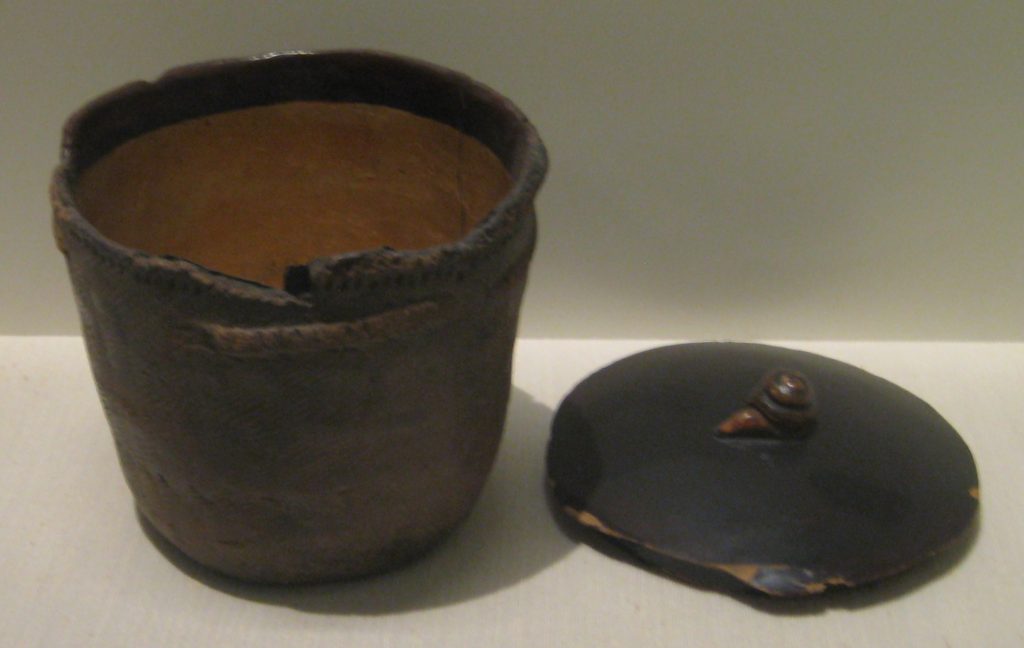
Throughout this video we’ve focused on how we affect our food and how it affects us. Once you’ve really mastered farming and start having surplus, you have to have a place to put it. You may think pottery didn’t really get going until after the agricultural revolution 9-10,000 years ago. But, you’d be wrong. Pottery has been found dating back 16,500 years ago when people were still hunter-gatherers.
The world’s oldest pots come from Japan. This pot is 7,000 years old, a drop in the bucket of pottery tradition dating back 10,000 years prior. While small and rather dull, the cord pattern is where its name comes from, the Japanese word Jomon. This pot doesn’t just reveal a long tradition of pottery, but the people who made it, and the historical period in which they were made: all called Jomon.
According to Japanese culture expert, Simon Kaner, of the University of East Anglia:
“In Europe we’ve always assumed that people who made pottery were farmers, and that it was only through farming that people were able to stay in one place, because they would be able to build up a surplus on which they could then subsist through the winter months, and it was only if you were going to stay in one place all the year round that you’d be making pottery, because it’s an awkward thing to carry around with you. But the Japanese example is really interesting, because here we have pottery being made by people who were not farmers. It’s some of the best evidence we have from prehistory anywhere in the world that people who subsisted on fishing, gathering nuts, and other wild resources, and hunting wild animals also had a need for cooking pots.”
Japanese culture expert, Simon Kaner, of the University of East Anglia
The Jomon lived near the sea and their main food, fish, came to them so the Jomon did not need to be nomadic like other hunter-gatherers. There was abundant nuts & seeds available, so they didn’t need to cultivate crops or domesticate livestock. While Japan beat the rest of the world in pottery, it was very late to the farming game, with simple rice cultivation beginning only 2,500 years ago.
Before pottery, humans stored food in the ground like a common squirrel or kept it in woven baskets. Both offered little-to-no protection against thieving insects and perfidious rodents. But a sturdy clay container offered significantly more protecting against other animals and the elements. Not only did the pots have a strong storage buff, but it was also leak-proof and most importantly, heat resistant. The ability to boil was a huge accomplishment. Many foods only become edible once they can be boiled, like shellfish for instance. Because of this technological marvel, Japan is the birthplace of both soup and stew. They could boil vegetables, nuts, clams, oysters, cockles, and meat.
While pottery started in Japan, like writing, mathematics, and agriculture, it was invented in many places throughout the world independently. Pots were invented in the Middle East a few thousands years after Japan, and in the Americas a few thousand years further.
